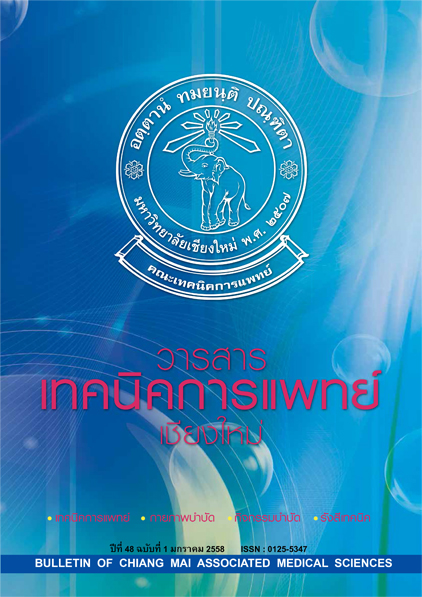An Outbreak of type B botulism in Chaiyaphum Province, Thailand 2014
Main Article Content
Abstract
Introduction: Clostridium. botulinum strains that produce types A and B to in generally associated with several outbreaks in the United States, China, South Amerca and southern European countries, and the most frequently implicated foods are vegetables. Diagnosis of botulism has been made by detecting the neurotoxin and C. botulinum cells in patients and/or suspected food samples. The aim of this study was to identify the cause of foodborne outbreak and analysis the symptoms of botulism in Chaiyaphum Province, 2014.
Materials and methods: The samples from Chaiyaphum Province outbreak were comprised of suspected food and clinical samples from 4 patients. Total 11 samples were identified by the cultivation, mouse bioassay and typing toxin genes amplication by multiplex PCR. The subtypes B1-B8 were compared based on the amino acid sequences alignment of bont/B1 to B8 subtypes using MEGA software which produce an unweighed pair group method with arithmetic mean (UPGMA).
Results: The clinical symtoms were observed especially with blurred vision, glossoplegia, dysarthria, nausea, dyspnea and required mechanical ventilation for support breathing.The etiological agent of this foodborne botulism outbreak detected by culturing, mouse bioassay and multiplex PCR method in fermented bamboo shoots contaminated was C. botulinum type B8. The phylogenetic tree of Chaiyaphum 2014 strain was constructed and the result demonstrated an identical to B8 subtype of Surat Thani 2012 strain (KC 714045).
Conclusions: From this study showed that the etiologic agent of an outbreak in Chaiyaphum Province was fermented bamboo shoot contaminated with C. botulinum type B8. Botulism disease must be considered clinical symptoms which was important to provide treatment of patients in time. It should combine with laboratory diagnosis in order to obtain the accurate results.
Bull Chiang Mai Assoc Med Sci 2015; 48(1): 49-58. Doi: 10.14456/jams.2015.3
Article Details
Personal views expressed by the contributors in their articles are not necessarily those of the Journal of Associated Medical Sciences, Faculty of Associated Medical Sciences, Chiang Mai University.


